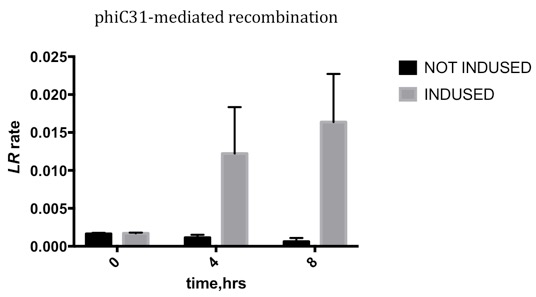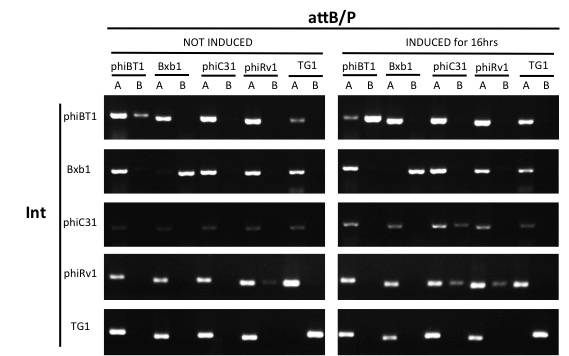Part:BBa_K1039012
PhiC31 integrase
PhiC31 integrase is a serine integrase that catalyzes site-specific recombination between PhiC31 attP (BBa_K103900) and attB (Bba_K1039036) sites to produce PhiC31 attR (Bba_K1039037) and attL (Bba_K1039038) sites. This recombination is unidirectional, i.e. attR and attL do not recombine in the presence of PhiC31 integrase alone. (1)
In concert with PhiC31 recombination directionality factor (RDF) (BBa_K1039013), PhiC31 integrase catalyzes site-specific recombination between PhiC31 attR and attL sites, to produce PhiC31 attP and attB sites. This recombination is also unideirectional, i.e. attP and attB cannot be recombined to produce attL and attR in the presence of PhiC31 integrase and RDF.
PhiC31 integrase can be used to flip the PhiC31 invertible promoter switches BBa_K1039009 and BBa_K1039008 from PB state to RL state.
In concert with B PhiC31 RDF (BBa_K1039013), PhiC31 integrase can be used to flip the PhiC31 invertible promoter switches BBa_K1039010 and BBa_K1039011 from RL state to PB state.
References: 1. Groth, Amy C., and Michele P. Calos. "Phage Integrases: Biology and Applications." Journal of Molecular Biology. 335.3 (2004): 667-678.
Characterization by Fudan_China 2017
- Group: Fudan_China 2017
- Author: Haiyun Liu, Fudan University
We characterized the kinetic characterization and the orthogonality between phiC31 and some other serine recombinase. The attB/P site we used for these experiments were phiC31 attB (BBa_K2460010) and attP (BBa_K2460011)
Kinetic Characterization
We conducted qPCR to record the ratio of attL/R to the sum of attL/R and attB/P, to characterize the efficiency varying with time.
Genetic design
- The integrase is expressed under a PBad promoter (BBa_I13453). Considering the leakage of PBad promoter would lead to flipping,the promoter is followed by a weaker RBS (BBa_B0033). Ahead of the promoter,an attB and attP are opposite to each other,flanking a 50 bp random sequence. This construct was cloned on a medium copy plasmid with p15A replication of origin and kanamycin resistance.
- To reduce leakage when not induced, AraC is expressed under a constitutive promoter, cloned on a high copy plasmid with pUC19 replication of origin and Ampicillin resistance.
Experimental Setup
- Since transforming the two plasmid above at a time was unable to prevent the flipping, the plasmid with AraC was first transformed into E.coli DH10b, then the plasmid with the integrase was transformed into the competent cell with the AraC plasmid.
- After culturing for over 2 hours in 2×YT borth, the cells were induced in 1% Arabinose for 8 hours. We sampled the culture at 0 hour, the 4th hour and the 8th hour.
- We calculated flipped and unflipped random sequence by qPCR.
Results
Before inducing, the LR rate remained a very low level, and after inducing for 8 hours, the LR rate showed an obvious change, which means the phiC31 integrase is functional.
Orthogonality Characterization
Since our circuit are using multiple integrases, it's important that the attB/P site of one integrase won't be flipped by one another integrase. We conducted orthogonality tests to see the compatibility between our integrases, including phiBT1 (BBa_K2460001), Bxb1 (BBa_K907000), phiC31 (BBa_K1039012), phiRv1 (BBa_K2460004) and TG1 (BBa_K2460007) integrase.
Genetic design
- 5 pairs of attB/P sites are each flanking a 50 bp random sequence, lining up ahead of the PBad promoter (BBa_I13453), an RBS (BBa_B0033) and an integrase. This construct was cloned on a medium copy plasmid with p15A replication of origin and kanamycin resistance.
- The same AraC plasmid in Kinetic Characterization was used in orthogonality Characterization.
Experimental Setup
- The same method of transformation in Kinetic Characterization was used in Kinetic Characterization.
- After culturing for over 2 hours in 2×YT borth, the cells were induced in 1% Arabinose 16 hours.
- Conduct PCR for each integrase's test and control group with primers from 5 pairs of attB/P sites, 2 pairs of primers for each pair of attB/P site.
Results
Expect for the phiC31 attB/P site, none of the attB/P sites flipped, indicating that phiC31 integrase has a good orthogonality with other attB/P sites, except phiRv1.
Sequence and Features
- 10COMPATIBLE WITH RFC[10]
- 12COMPATIBLE WITH RFC[12]
- 21INCOMPATIBLE WITH RFC[21]Illegal XhoI site found at 51
- 23COMPATIBLE WITH RFC[23]
- 25COMPATIBLE WITH RFC[25]
- 1000INCOMPATIBLE WITH RFC[1000]Illegal SapI site found at 1665
Illegal SapI.rc site found at 1356
Illegal SapI.rc site found at 1414
Illegal SapI.rc site found at 1519
| None |


